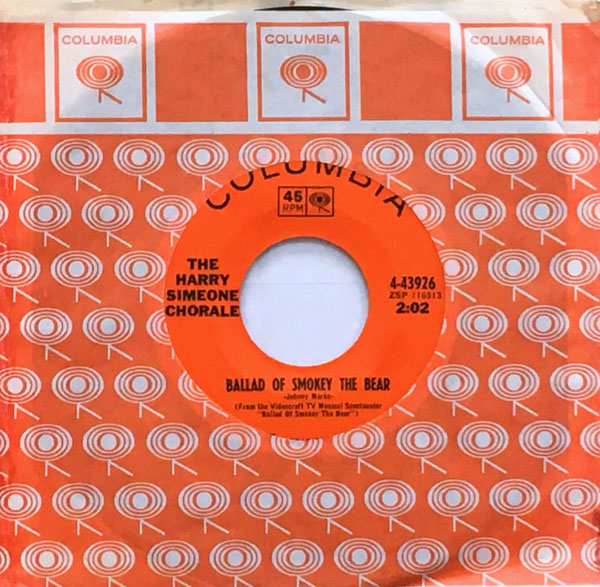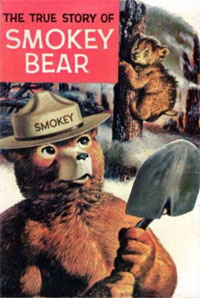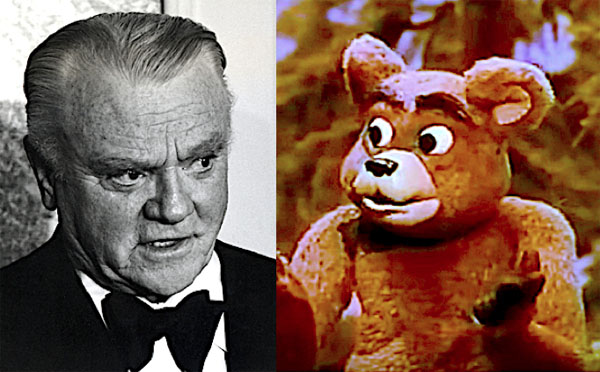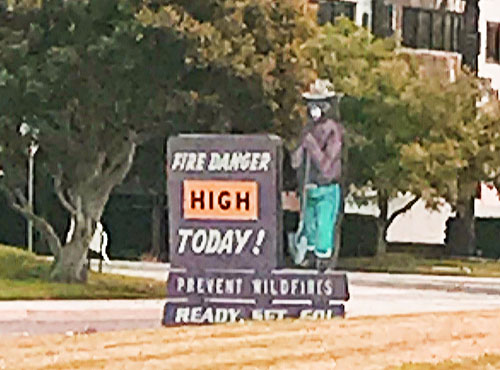A vinyl-sided look at the enduring legend of a beneficent bear whose paths crossed with James Cagney, Walt Disney, Lyndon and Lady Bird Johnson—even Bullwinkle J. Moose!

“ANYONE CAN MOVE A MOUNTAIN”
and “BALLAD OF SMOKEY THE BEAR”
From the Videocraft TV Musical Spectacular “Ballad of Smokey the Bear”
The Harry Simeone Chorale
Columbia Records (7” 45 rpm single)
Released in 1980. Music and Lyrics: Johnny Marks. Running Time: 5 minutes.
Walt Disney and Bambi were partially responsible for the creation of Smokey Bear. The U.S. Forest Service was ramping up public participation in fire prevention the same year Bambi was released and Disney granted the service one year’s use of the characters from the feature as mascots for the program. Obviously, it worked, because after the contract ended, they had to come up with a new character. In 1944, a fictional bear was dubbed “Smokey” after New York City fireman “Smokey” Joe Martin, a victim of severe burns (one wonders if Pablo, “The Penguin Who Hated the Cold” in The Three Caballeros, named his stove “Smokey Joe” after the same person).
As the Smokey Bear website timeline chronicles, the character has remained a robust and powerful example of “cause marketing.” There is a walk-around Smokey that visits kids. He’s been honored on a postage stamp. NASA sent him into space. Disney did not cease its support of fire prevention programs and created public service announcements that combined Smokey and Bambi, like this one from 1964.
The reason his name often has “the” added into the middle is because of things like the popular song introduced by country star Eddy Arnold written by Steve Nelson and Jack Rollins, who also wrote “Frosty the Snowman” and “Peter Cottontail.” Musically, it just works better. The song was recorded many times, especially by children’s record labels like Golden and Peter Pan. The singer of the Peter Pan version is listed as “Johnny Jones.”
Golden Books also added “the” for its never-out-of-print 1955 storybook originally titled The True Story of Smokey the Bear. The story was called “true” because a real-life bear was actually rescued from a tall tree in the midst of a 1950 forest fire. This living symbol was a celebrity, getting thousands of letters every week, until he passed away in 1976.
 Arthur Rankin, Jr. and Jules Bass had enjoyed a successful partnership with General Electric with their first two animated specials, Return to Oz and Rudolph, the Red-Nosed Reindeer. Both aired under the umbrella title of the “GE Fantasy Hour” in 1964 and were rerun in 1965. Rudolph in particular was such a success that GE ordered a third “Fantasy Hour” from what was then called Videocraft International (but soon to be Rankin/Bass Productions).
Arthur Rankin, Jr. and Jules Bass had enjoyed a successful partnership with General Electric with their first two animated specials, Return to Oz and Rudolph, the Red-Nosed Reindeer. Both aired under the umbrella title of the “GE Fantasy Hour” in 1964 and were rerun in 1965. Rudolph in particular was such a success that GE ordered a third “Fantasy Hour” from what was then called Videocraft International (but soon to be Rankin/Bass Productions).
All three specials were born from astute marketing and programming strategy on the part of NBC, GE, Rankin (who was previously an art director at ABC) and Bass (who was an advertising copywriter). Return to Oz was a good choice since MGM’s The Wizard of Oz had already been an annual TV event since 1956 and Videocraft could draw elements and resources from its previous syndicated Tales of the Wizard of Oz cartoon series.
Rudolph made sense because the holiday special market had not really been tapped except for Mister Magoo’s Christmas Carol in 1962.
 On Thanksgiving Day morning in 1966, the Macy’s Thanksgiving Day Parade introduced the new Smokey Bear balloon. While other networks would not have mentioned it, NBC—which traditionally still offers the widest Macy’s broadcast coverage—took advantage of its deliberate presence to tie it into the brand-new animated musical spectacular airing later that same day: Ballad of Smokey the Bear, told by James Cagney.
On Thanksgiving Day morning in 1966, the Macy’s Thanksgiving Day Parade introduced the new Smokey Bear balloon. While other networks would not have mentioned it, NBC—which traditionally still offers the widest Macy’s broadcast coverage—took advantage of its deliberate presence to tie it into the brand-new animated musical spectacular airing later that same day: Ballad of Smokey the Bear, told by James Cagney.
GE and NBC were clearly looking to capture lightning in another bottle, as the character of Smokey the cub displays so much of Rudolph the buck’s insecurity and solitude. But rather than a quest, this story stays in one place and allows the family of animals to come up with various solutions, while children at home are given gentle lessons on conservation.
Conservation helped drive the making of the special. According to Arthur Rankin’s own recollections in the book, The Enchanted World of Rankin/Bass by Rick Goldschmidt, the producer/director knew that conservation was important to Cagney as well as the Lyndon Johnson White House. The “Keep America Beautiful” campaign had enlisted the support of Lady Bird Johnson the previous year.
Cagney turned Rankin down, so Rankin contacted the Secretary of Agriculture, Orville Freeman, who suggested that LBJ appear in live-action during the special. Rankin described his meeting with the President this way:
 “He said, ‘Well, we’re really excited about the Smokey the Bear idea. I’d like to help in any way I can. I’ve seen your work and I like it. Who’s going to play Smokey the Bear?’ I said, ‘Well, we’ve been talking to James Cagney.’ President Johnson said, ‘James Cagney! I love James Cagney! I love James Cagney! You give him my very best regards!’”
“He said, ‘Well, we’re really excited about the Smokey the Bear idea. I’d like to help in any way I can. I’ve seen your work and I like it. Who’s going to play Smokey the Bear?’ I said, ‘Well, we’ve been talking to James Cagney.’ President Johnson said, ‘James Cagney! I love James Cagney! I love James Cagney! You give him my very best regards!’”
Rankin knew an executive order when he heard it. Even though Cagney had given him a firm and final “No,” Rankin contacted him again. Cagney asked Rankin to have Johnson sent him a letter asking him to do the special. Orville Freeman took care of it and the deal was made. When Rankin met Cagney at his farm in upstate New York to record the dialogue, Rankin was stunned by the reception:
“He says to me as I walk in, ‘I knew your grandfather. I knew your father and I knew your Aunt Doris.’ He knew them from his days in Vaudeville, but never told me this on the phone.”

Cagney did not play Smokey as President Johnson expected, but instead narrates and takes part in the story as Big Bear, Smokey’s older brother. He is the one who rescues Smokey from the tall tree instead of a human ranger.
Cagney may be the only narrator of a Rankin/Bass musical special who did not sing any songs. The other voices are top New York session singers, stage and commercial actors. Of particular note are William (Bill) Marine, who plays Mr. Turtle. He and musical director Maury Laws went back many years into the Cricket children’s record days when he sang and/or narrated on discs like “Peter Cottontail and the Search for Flopsy’s Tail,” which we mentioned in an earlier Animation Spin.
Also of note are the two actors playing the Beaver couple. Herb Duncan and Rose Marie Jun also played the “New York Cast” version of another animated couple, George and Jane Jetson, on the 1962 Golden Records LP that we explored in this Spin. Rose Marie Jun belted out the immortal “Push Button Blues.”
Ballad of Smokey the Bear remains of one the most obscure of Rankin/Bass films. It has never been released on home video, cable or streaming services. Unless the rights are still tied up in the Cagney estate or something, this low-key production has a year-round play value with virtually no competition from rival Smokey Bear animated properties.
“Ballad of Smokey the Bear” & “Anyone Can Move a Mountain”
Johnny Marks, who had scored for GE, Decca Records and his own St. Nicholas Music publishing company with his Rudolph songs, provided seven new tunes for this show, including “Delilah” (not to be confused with the creepy Tom Jones pop song), “Tell It To A Turtle,” “Don’t Wait,” “All Together,” “Curiosity” and the only two songs to be recorded, “Anyone Can Move a Mountain” and the title song. There was no soundtrack album, perhaps because there was no headlining singer to promote, as there was with Burl Ives and Rudolph.
“Anyone Can Move a Mountain” was selected as the song with the greatest hit potential by Columbia Records, so it was released as a single by The Harry Simeone Chorale, best known for “The Little Drummer Boy.”
The title song for Ballad of Smokey the Bear was the featured song on this 1969 RCA Camden release, followed by other animal character-related tunes. Richard Wolfe also conducted many albums for the “Do-Re-Mi Children’s Chorus” for Kapp Records, which were very popular in the ‘60s. We featured their Mary Poppins LP here.
Smokey the Bear was an ideal subject for several children’s records. The 1976 Disney read-along featured Lucille Bliss (Cinderella, Crusader Rabbit, Smurfs) reading the entire book with no additional cast, which was unusual for the Jymn Magon-produced read-alongs of the era. In this case, there was very little dialogue. It was adapted from the 1955 Golden Book “true story.” An earlier version was released by Golden Records. New York TV and recording personality Kay Lande (Birthday House) read the text by Jane Werner.
Several actors did the voice of Smokey Bear, including Jack Angel (who voiced him in the 1966 special), Dal McKennon, Roger C. Carmel, Jim Cummings, Gene Moss, George Walsh and presently, Sam Elliott. His original and longest-running voice (though some of these other actors played Smokey as needed along the way), was announcer and radio personality Jackson Weaver.
Weaver was a fixture of the Washington, D.C. airwaves for sixty years on WMAL-AM radio. For 32 of those years, he teamed with Frank Harden for one of the most popular morning drive programs of the era, The Harden and Weaver Show. His voice, familiarity and renown in Washignton made Weaver a natural for the voice of Smokey, beginning in 1947.
When Donald Duck tangled with Humphrey the Bear in the 1956 short In the Bag, there’s a cameo by Smokey and Weaver provides the voice of Smokey for the big screen.
SMOKEY BEAR AND HIS FRIENDS
“KEEP AMERICA BEAUTIFUL”
MGM Leo the Lion Records CH-1014 (12” 33 1/3 RPM LP / Mono)
Released in 1966. Producer: Herb Galewitz. Liner Notes: Lady Bird Johnson. Writer: Feather Schwartz. Musical Director: Frank Metis. Engineer: Bill Syzmczyk. Engineering Director: Val Valentine. Recorded at Regent Sound, New York. Voices: Jackson Weaver, Ron Marshall, Madeline Lee and Ruth Franklin. Running Time: 33 minutes.
Songs: “Go to the People,” “Let’s Keep America Beautiful,” “Love That Eel,” “Remember Me,” “Keep the Highways Clean,” “A Balance of Nature,” “Why Blame Us?” “They’re Spoiling City Air,” “Save Some Water” by Feather Schwartz.
Weaver also voiced Smokey on two children’s albums that were available nationwide for several years. The first one was released the same year as the television special on the MGM Leo the Lion label, called Smokey the Bear and His Friends: Keep America Beautiful. The album’s writer, Feather Schwartz, also authored Casper the Friendly Ghost: A Trip Through Ghostland for Golden Records (see this Spin). Lady Bird Johnson provided a lengthy message to listeners for the liner notes. The script and songs focus on a number of important conservation and safety issues.
One of the voices is singer/actor Ron Marshall, of the Rankin/Bass specials The Year Without a Santa Claus and The Easter Bunny is Comin’ To Town.
SMOKEY BEAR WITH RANGER HAL
Golden Records LP-203 (12” 33 1/3 RPM LP / Mono)
Released in 1967. Producer/Musical Director: Ralph Stein. Running Time: 29 minutes.
Voices: Jackson Weaver (Smokey Bear, Honker); Hal Shaw (Ranger Hal, Oxxie, Dr. Fox); Jere Hathaway Wright (Aunt B.); Ronald E. Nicodemus (Sammy Skunk, Additional Voices); Rosemary Shaw (Additional Voices).
Songs: “We’re Going to Have a Picnic,” “What Do Want To Know About the U.S.A.?” “Smokey and Skunk,” “Poison Ivy,” “The Rules of Smokey Bear,” “Keep America Green,” “Litter, Litter Everywhere,” “My Friend is Ranger Hal,” “Here is America” by Jere Hathaway Wright and Judy Kretsinger.
Golden Records’ album takes a slightly lighter approach with its messaging than the MGM album, adding in some musical emphasis on the animal characters as well. (Interesting vocal note: Hal Shaw coincidentally uses an intellectual “Richard Haydn/Clyde Crashcup” voice for Dr. Fox just as William Marine does for Mr. Turtle in the Rankin/Bass special.)
Jackson Weaver returns as Smokey, with “Ranger Hal” Shaw, a local Washington, D.C. children’s TV host of the sixties (who co-wrote the script with Jere Hathaway Wright). Like most of the Smokey stories, the adventures of his friends in the forest (and the occasional human) tie into important issues of pollution, fire prevention, using a litter bag, etc.
Musical director Ralph Stein brings his specific brand of laid-back easy jazz to the music, much like those on his many other Golden and Pickwick records—for which he made over a hundred different titles. Nashville and New York music Producer Dennis Scott, who is in the running for his third Grammy for the star-driven Thank You Mister Rogers: Music and Memories, started his career at the dawn of Golden Records (which had become Wonderland):
“As experienced as he was, Ralph was just as humble,” Dennis told me. “I never saw him stress out about anything. He was an easy-going guy with a very ‘cool’ vibe about him. I recall him wearing a turtle neck shirt with a gold medallion on a chain around his neck. Ralph understood that the secret to a successful recording session was to hire great players and just get out of the way, so he gave me a free hand in selecting the musicians for the session. Due to budgetary restraints, there were no overdubs and not too many retakes on my very first album, Songs That Tickle Your Funny Bone, Volume Three. He was always encouraging and his calming personality made him one of the finest people I’ve worked within the industry.”
Rankin/Bass starred Weaver in Smokey’s first TV series on ABC in 1969, this time in cel animation by Mushi Studios. The Smokey the Bear Show had its roots in comic books, lifting characters and stories for many of the episodes, none of which came from the 1966 special or any of the records. Johnny Marks’ theme was replaced by an original theme song by Maury Laws and co-producer Jules Bass.
Animation legend Shamus Culhane and famed lyricist Hal Hackady (Snoopy the Musical, which we discussed in this Spin) are given writing credit, but that may or may not be because of the comic book sources. Each half-hour contained two Smokey cartoons with Weaver’s voice and one about cub Smokey played by Billie Mae Richards, the voice of Rudolph. The series was later syndicated.
Smokey really got around, from Rankin/Bass to Disney and even to Jay Ward Productions, where his image appeared in this memorable (and frequently aired) PSA for fire prevention.
Smokey continues keeping us alert for wildfires. A single smoldering ember can exist beneath the brush and when stirred by the wind, that is all it takes for acres or lives and property lost. Even the home of Charles M. Schulz was destroyed by wildfire in 2017.

Your author has had to leave home as wildfires filled the sky with red and black and police bullhorns ordered immediate evacuation. We take Smokey’s warning sign seriously. Quite a “relevant” character for a 76-year-old.


 GREG EHRBAR is a freelance writer/producer for television, advertising, books, theme parks and stage. Greg has worked on content for such studios as Disney, Warner and Universal, with some of Hollywood’s biggest stars. His numerous books include Mouse Tracks: The Story of Walt Disney Records (with Tim Hollis). Visit
GREG EHRBAR is a freelance writer/producer for television, advertising, books, theme parks and stage. Greg has worked on content for such studios as Disney, Warner and Universal, with some of Hollywood’s biggest stars. His numerous books include Mouse Tracks: The Story of Walt Disney Records (with Tim Hollis). Visit 





















































Smokey the Bear makes a cameo on the HBR album “Hansel and Gretel starring The Flintstones” voiced by Mel Blanc. Though Blanc plays the character straight, it’s a very tongue-in-cheek gag that comes out of nowhere and has no tie-in to the story, but is hysterically funny. A parody of the many PSA’s featuring Smokey that were in proliferation at the time.
I love that album! The HBR cartoon series was spectacular.
I grew up listening to Harden & Weaver every morning AND watching Ranger Hal, so that LP brings back a lot of memories to me (although by the time it was released, I was probably too old to have been interested in that “kid stuff”). It’s interesting to note that “[The Ballad of Smokey the Bear] has never been released on home video, cable or streaming services” but we’re lucky that it is readily available online (as is “Little Smokey,” a live-action short produced by the Forest Service and featuring William “Hopalong Cassidy” Boyd).
My high school choir used to do a lot of Harry Simeone arrangements. Once before class I drew a cartoon on the chalkboard showing a chorus of singing apes, with the caption: “The Hairy Simian Chorale.”
I can think of at least one other actor who narrated a Rankin/Bass special but didn’t sing in it: Greer Garson, in “The Little Drummer Boy” — though she did sing “I Heard the Bells on Christmas Day” in its sequel.
I don’t recall seeing “The Ballad of Smokey the Bear” when it first aired, but I’m sure I would have loved it. “Don’t Wait” is sort of a jazzed-up version of “There’s Always Tomorrow” from the Rudolph special.
I do remember the Smokey TV series, which aired at 7 AM on Saturday morning. I made a point of getting up early to catch it.
In Australia, “High” is actually the lowest fire danger rating. It goes from there to Very High, Severe, Extreme, and Catastrophic. I’ll never forget last New Year’s Eve, when the bushfires were close enough to my house to turn the night sky red. So I have an idea what you’re going through, and I hope you’ll get through it okay.
Greer Garson also sang in The Happiest Millionaire, but the Sherman Brothers’ song was cut in the initial release, even though Camarata released a single version. Thanks to people like Stacia Martin, it was restored and added back into the restored DVD. The Supremes recorded it for their holiday album:
https://www.youtube.com/watch?v=VYJG3G-s0fg&pbjreload=101
I remember seeing the Smokey the Bear special once during the nineties on whatever the Family Channel (now Freeform) was called back then. They were showing a lot of the lesser known Rankin-Bass specials back then, including Nestor the Long Eared Donkey and The Leprechaun’s Christmas.
Wish I could have seen what it looked like with a decent print in color. Maybe that means it is feasible as a possible current release.
I had that 1966 MGM SMOKEY THE BEAR record..for years..!
Another Bullwinkle tie-in: the infamous Stokey the Bear Dudley Do-Right episode was aired one time, raising the hackles of the U.S. Forest Service which caused it to be pulled from reruns. It finally made a legit appearance in the Bullwinkle dvd reissues:
https://www.youtube.com/watch?v=e3K1PDM93fI
The 1969 Bullwinkle/Smokey p-s-a is a little surprising in light of the Forest Service’s notable unhappiness with the Ward studio’s satiric treatment of Smokey in an early ’60s Dudley Do-Right adventure.
In “Stokey the Bear,” an iconic forest ranger bear (who, of course, greatly resembles Smokey) comes under the evil influence of Snidely Whiplash and begins starting fires instead of preventing them! This aired just once on NBC and aroused a certain amount of outrage and complaint regarding such treatment of a familiar, beloved national symbol of conservation. It would be interesting to see the resulting correspondence between the Forest Service, the network and the Ward offices. At any rate, I don’t believe the segment was ever re-aired (even in syndication), and wasn’t seen again until Sony/Classic Media released the Bullwinkle DVD sets.
Apparently there was eventually some rapprochement between the Forest Service and Jay Ward. At any rate, it’s nice to see our favorite cartoon moose giving Smokey — and fire prevention — a mostly straight-faced boost here. I do like that Bullwinkle seems to be reading the copy for the p-s-a as he speaks — he’s acting like a true celebrity!
I’m thinking Ward did it as a “make-good” for the issue, as this aired often in the late 60s. I knew it so well as a kid that when our Cub Scout troop visited a fire station, I started to recite Bullwinkle’s poem. It kind of annoyed our Den Mother, who was actually a very kind person.
I remember the special as being very odd — giving Smokey relatives and a naughty girlfriend, then shifting gears to have an escaped gorilla stand in for careless humans. The series had zero connection to the special, although it also kept humans out of the picture. Smokey was essentially Sheriff Andy in a Mayberry run by animals.
I’m wondering if a rights issue stems from Smokey being government property — note that the special and the series have both been out of circulation for many years. Smokey was and is extensively merchandised (how many of your parents had those Smokey Bear cigarette-snuffers on the dashboard?) but I can’t think of any other film or TV appearances outside of what’s reported here.
Back in the 80s I accidentally got to be Smokey Bear in a holiday parade. Smokey’s costume came with a page of rules on government stationary. It had many of the expected no-nos: Never be seen without the head, no talking, etc. It also had very firm rules against handling or otherwise interacting with matches or anything smoking-related. There was a hint of federal reprisals if you made Smokey look bad.
There are some moments of genuine genius in the character animation of the Rankin/Bass special. It was one of the last to be animated primarily by Tad Mochinaga (with assistant Hiroshi Tabata), and his sharp sense of timing shines through in James Cagney’s character, bearing a strong resemblance to the personality animation of Sam the Snowman in “Rudolph” while capturing subtleties unique to Cagney’s performance. “Ballad of Smokey the Bear” is also one of the first Rankin/Bass projects storyboarded/staged by stalwart Don Duga, fresh off of “The Daydreamer”, whose key poses and inspired camerawork offer a greater sense of depth and emotional context to the special’s visuals, woven into the naturalistic setdressing and Bambi-esque character design (unfortunately uncredited). Some of the top ‘underground’ animation talent of the time belonged to Rankin/Bass!
Hey Greg. A “Tuesday question” for you on another topic. The seemingly forgotten 1980 animated film “I Go Pogo” celebrates 40 years. There were some good songs mixed in with the election time antics of Walt Kelly’s animals – was there any vinyl soundtrack release that you know about? Maybe a future animation spin will tell the tail (of the possum).
Thanks,
Glenn
Good suggestion, Glenn. There was no soundtrack I know of for the “I Go Pogo” feature or the Birthday Special, but Golden/AA Records did do an album with Kelly himself in the late fifties. It’s on my list for someday.